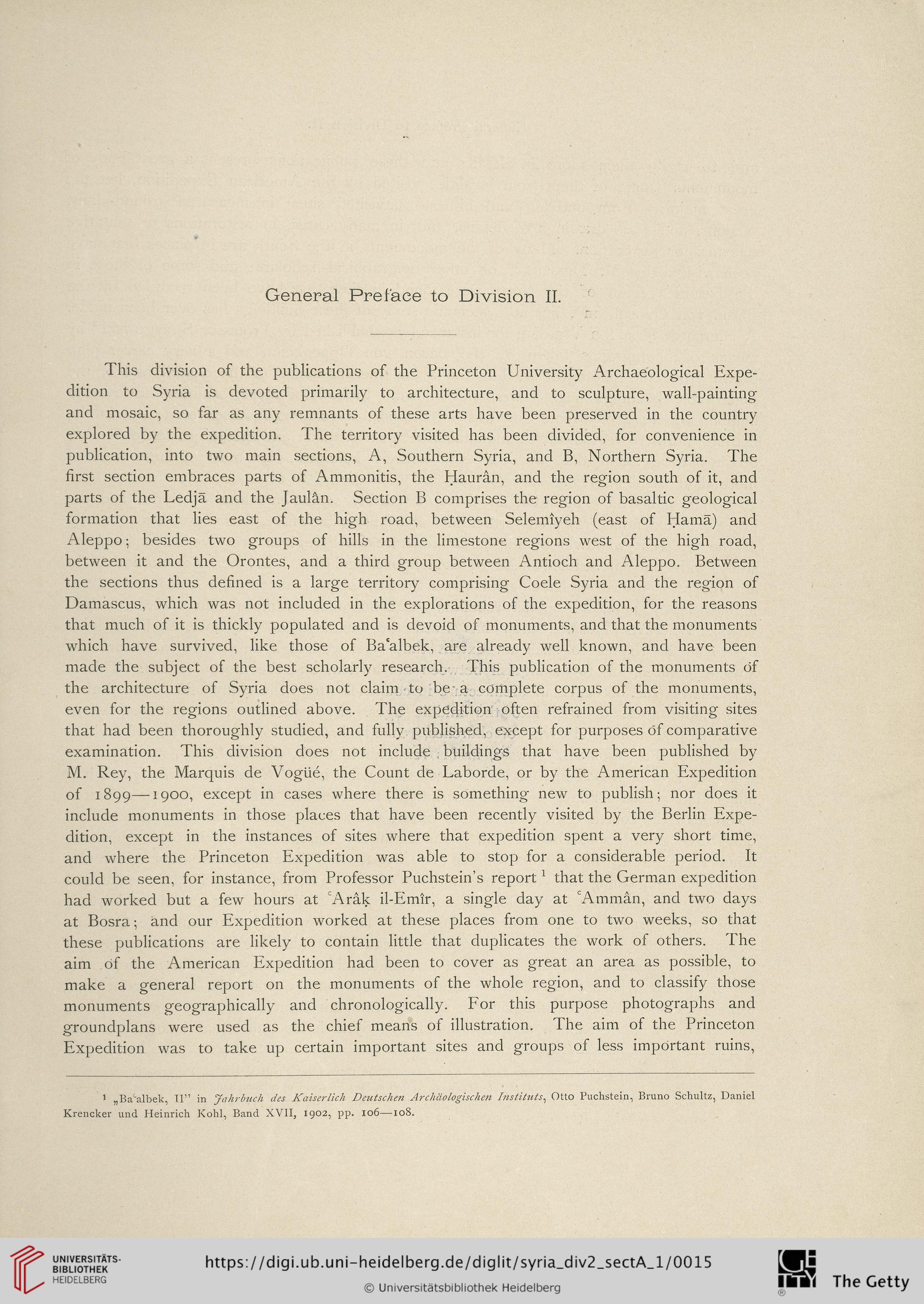General Preface to Division II.
This division of the publications of the Princeton University Archaeological Expe-
dition to Syria is devoted primarily to architecture, and to sculpture, wall-painting
and mosaic, so far as any remnants of these arts have been preserved in the country
explored by the expedition. The territory visited has been divided, for convenience in
publication, into two main sections, A, Southern Syria, and B, Northern Syria. The
first section embraces parts of Ammonitis, the Hauran, and the region south of it, and
parts of the Ledja and the Jaulan. Section B comprises the region of basaltic geological
formation that lies east of the high road, between Selemiyeh (east of Hama) and
Aleppo; besides two groups of hills in the limestone regions west of the high road,
between it and the Orontes, and a third group between Antioch and Aleppo. Between
the sections thus defined is a large territory comprising Coele Syria and the region of
Damascus, which was not included in the explorations of the expedition, for the reasons
that much of it is thickly populated and is devoid of monuments, and that the monuments
which have survived, like those of Ba'albek, are already well known, and have been
made the subject of the best scholarly research. This publication of the monuments of
the architecture of Syria does not claim to be a complete corpus of the monuments,
even for the regions outlined above. The expedition often refrained from visiting sites
that had been thoroughly studied, and fully published, except for purposes of comparative
examination. This division does not include buildings that have been published by
M. Rey, the Marquis de Vogue, the Count de Laborde, or by the American Expedition
of 1899—1900, except in cases where there is something new to publish; nor does it
include monuments in those places that have been recently visited by the Berlin Expe-
dition, except in the instances of sites where that expedition spent a very short time,
and where the Princeton Expedition was able to stop for a considerable period. It
could be seen, for instance, from Professor Puchstein’s report1 that the German expedition
had worked but a few hours at "Arak il-Emir, a single day at "Amman, and two days
at Bosra; and our Expedition worked at these places from one to two weeks, so that
these publications are likely to contain little that duplicates the work of others. The
aim of the American Expedition had been to cover as great an area as possible, to
make a general report on the monuments of the whole region, and to classify those
monuments geographically and chronologically. For this purpose photographs and
groundplans were used as the chief means of illustration. The aim of the Princeton
Expedition was to take up certain important sites and groups of less important ruins,
1 „Bacalbek, Π” in Jahrbzich des Kaiserlich Deutschen Archaologischen Instituts, Otto Puchstein, Bruno Schultz, Daniel
Krencker und Heinrich Kohl, Band XVII, 1902, pp. 106—108.
This division of the publications of the Princeton University Archaeological Expe-
dition to Syria is devoted primarily to architecture, and to sculpture, wall-painting
and mosaic, so far as any remnants of these arts have been preserved in the country
explored by the expedition. The territory visited has been divided, for convenience in
publication, into two main sections, A, Southern Syria, and B, Northern Syria. The
first section embraces parts of Ammonitis, the Hauran, and the region south of it, and
parts of the Ledja and the Jaulan. Section B comprises the region of basaltic geological
formation that lies east of the high road, between Selemiyeh (east of Hama) and
Aleppo; besides two groups of hills in the limestone regions west of the high road,
between it and the Orontes, and a third group between Antioch and Aleppo. Between
the sections thus defined is a large territory comprising Coele Syria and the region of
Damascus, which was not included in the explorations of the expedition, for the reasons
that much of it is thickly populated and is devoid of monuments, and that the monuments
which have survived, like those of Ba'albek, are already well known, and have been
made the subject of the best scholarly research. This publication of the monuments of
the architecture of Syria does not claim to be a complete corpus of the monuments,
even for the regions outlined above. The expedition often refrained from visiting sites
that had been thoroughly studied, and fully published, except for purposes of comparative
examination. This division does not include buildings that have been published by
M. Rey, the Marquis de Vogue, the Count de Laborde, or by the American Expedition
of 1899—1900, except in cases where there is something new to publish; nor does it
include monuments in those places that have been recently visited by the Berlin Expe-
dition, except in the instances of sites where that expedition spent a very short time,
and where the Princeton Expedition was able to stop for a considerable period. It
could be seen, for instance, from Professor Puchstein’s report1 that the German expedition
had worked but a few hours at "Arak il-Emir, a single day at "Amman, and two days
at Bosra; and our Expedition worked at these places from one to two weeks, so that
these publications are likely to contain little that duplicates the work of others. The
aim of the American Expedition had been to cover as great an area as possible, to
make a general report on the monuments of the whole region, and to classify those
monuments geographically and chronologically. For this purpose photographs and
groundplans were used as the chief means of illustration. The aim of the Princeton
Expedition was to take up certain important sites and groups of less important ruins,
1 „Bacalbek, Π” in Jahrbzich des Kaiserlich Deutschen Archaologischen Instituts, Otto Puchstein, Bruno Schultz, Daniel
Krencker und Heinrich Kohl, Band XVII, 1902, pp. 106—108.




